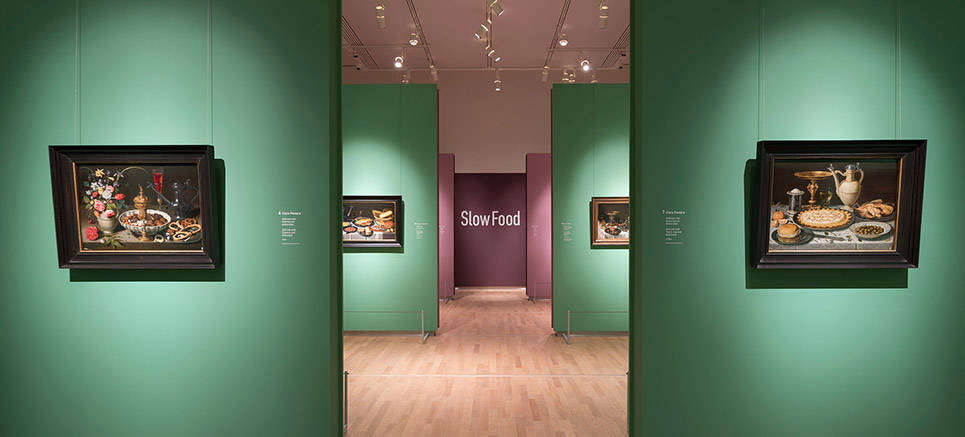Astonishing detail
Masters of the meal still life depicted refined delicacies such as fish, oysters, prawns, cheese, bread, olives and nuts, offset by fine glassware, gilded goblets, pottery jugs or oriental porcelain. The way in which the details have been rendered is a feat of extraordinary precision, as is the play of light on the various materials. Peeters succeeds in replicating the somewhat crumbly texture of the biggest cheese and the creaminess of the butter curls on the plate with great accuracy in her Still Life with Cheeses, Almonds and Pretzels. The delicate play of light on the blade of the knife is also beautifully rendered. Virtuosity is also on display in the work of Claesz and Heda. In Heda’s impressive Still Life with Gilt Goblet dated 1635, for example, the suggestion of reflected light on the large glass is magnificent. The glass not only reflects the rays of light coming in through a window, but also the muted sheen of a silver tazza (shallow drinking bowl) and a gilded goblet. The reflection resembles a fine mesh on the glass and is a superb example of the craftsmanship that is so characteristic of these early meal still lifes.
Interpretation
The delicacies and precious objects shown in the meal still lifes evoke a utopian world free of hunger and need. The paintings often incorporate a sense of mortality, of the transience of earthly life. This vanitas symbolism is made explicit in the meal still lifes by Claesz and Heda, each of whom include a timepiece in their compositions. At the same time, a good meal also symbolises prosperity and well-being. It is possible that the cornucopia of food shown in the paintings was also intended as an exhortation to moderation. In a number of paintings by Peeters, for example, a knife with the word ‘TEMP[ERANTIA]’ (moderation) on its blade figures prominently. Her aim may have been to impart a deeper meaning to her compositions.
Mini food festivals
The museum will organise a series of small-scale food festivals during the exhibition, which will centre on the delicacies depicted in the paintings. A range of activities focused on food and drink will also take place on four Saturdays during the exhibition. Each edition will focus on a different theme: 18 March – bread & cheese 22 April – meat & fish, 20 May – drinks & glassware,, 17 June – fruit & vegetables. For the duration of the exhibition there will be a greenhouse on the square of the Mauritshuis: Taste Station MH. For more information: mauritshuis.nl/slowfood
Catalogue
The Mauritshuis and Waanders Publishers will offer a catalogue to accompany the exhibition. Slow Food: Dutch and Flemish Meal Still Lifes 1600-1640 contains more than 150 colour illustrations, published in English (ISBN 978 94 6262 117 6) and Dutch (ISBN 978 94 6262 116 9). The catalogue is written by Quentin Buvelot, Senior Curator at the Mauritshuis, with additional contributions by Yvonne Bleyerveld, Milou Goverde, Zoran Kwak, Anne Lenders, Fred G. Meijer and Charlotte Rulkens. Price € 29.95.
Sponsors
The exhibition has been made possible thanks to the support of the Friends of the Mauritshuis Foundation, NN Group, Dutch Masters Foundation, Turing Foundation and BankGiro Loterij.
The compilation of the catalogue was aided in part by generous donations from the Stichting dr. Hendrik Muller’s Vaderlandsch Fonds and the Prince Bernhard Cultuurfonds.


